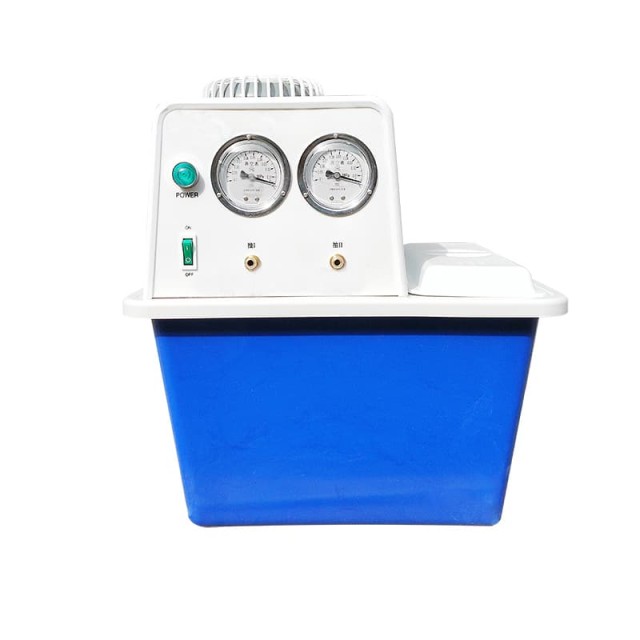
vacuum pump & cold trap chiller
Laboratory Benchtop Water Circulating Vacuum Pump for Lab Use
Item Number : KV-2
Price varies based on specs and customizations
- Vacuum port
- 2-4
- Single port flowrate
- 10 L/Min
- Vacuum pressure
- 0.098 Mpa
- Pump Flowrate
- 60 L/Min
- Pump heading
- 8 M
Shipping:
Contact us to get shipping details Enjoy On-time Dispatch Guarantee.
Why Choose Us
Reliable PartnerEasy ordering process, quality products, and dedicated support for your business success.
Applications
Water Circulating Vacuum Pump takes circulating water as working fluid to create negative pressure by fluid jet.
It can provide negative pressure condition for the processes of evaporation, distillation, crystallization, drying, sublimation, pressure-reducing filtration and so on, particularly be suitable for labs and small scale test of industries such as universities and colleges, scientific research institutes, chemical industry, pharmacy, biochemistry, foodstuff, pesticide, agricultural engineering, biological engineering.
Detail & Parts
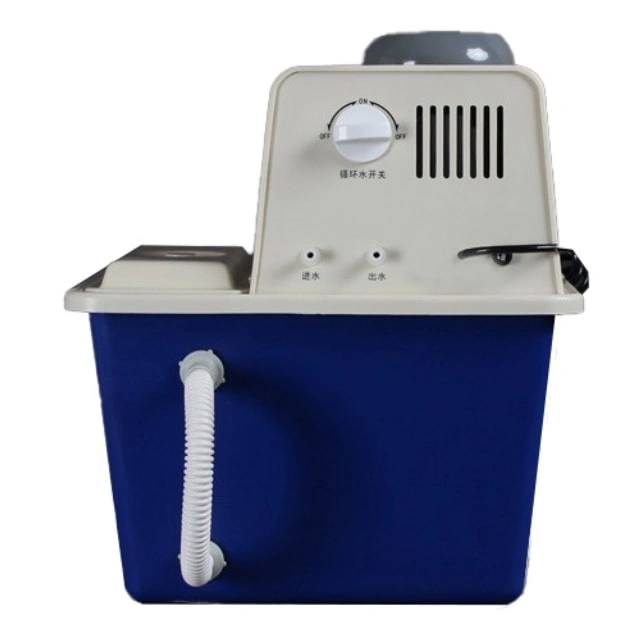
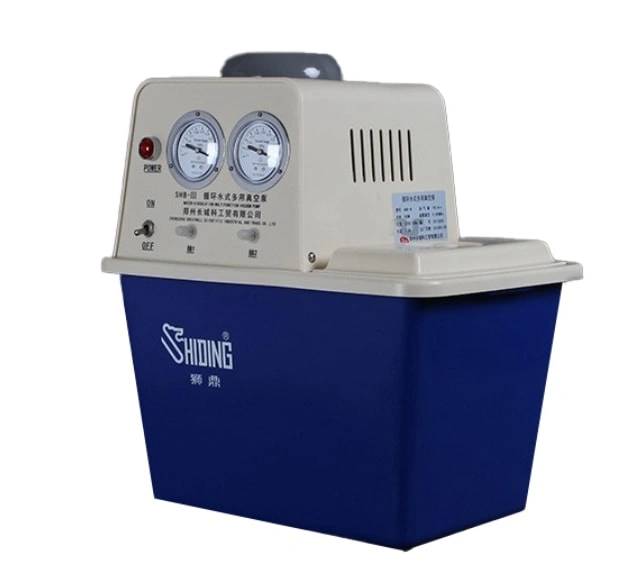




Analytical diagram of vacuum principle
left:1.motor;2.Motor Rubber Pad;3.Motor water blocking ring;4.pump shaft sleeve;5.washer;6.Impeller (six channels and double seals);7.Viton oil seal;8.Graphite bearing sleeve;9.oil seal;10.Pump casing seal;
right:1. Circulating nozzle;2. Ejector (vacuum bottle);3. Check valve;4. Vacuum gauge;5. Air intake;6. Air extraction nozzle;7. Fluid muffler;8. Jet flow;9. Air intake;10. Jet flow;11. Air intake;
| Detailed material | ||||||
| Ejector | check valve | Connecting pipe | three links | pump body | impeller | Air extraction nozzle |
| PP | Copper+PP | NR | PP | PP | PA | PP |
Advantages
- Spray Paint Teflon ( PTFE ) plus FV Rubber on the ejector and suction nozzle. Hose is made of fluorine rubber
- Better corrosion resistance and more reliability and longer service life
- Oil-free, corrosion resistant, reliable
- No oil changes, no cold trap required for water/ alcohol solutions
- Easy to maintain in laboratory environment
- Designed to work with rotary evaporators, vacuum filtration, etc
- High-quality anti-corrosion shell; newly-developed 5 taps can work separately or together with a 5-way pipe (optional) to
- Increase the extraction capacity and match working with large rotary evaporators and reactors
- Cooper jet and PP triple-valve, check valve, and suction mouth
- More extraction capacity compared with desktop vacuum pump
- Flexible moving around with steering wheels
- Eligible for extracting corrosive gas
Technical specifications
| Model | SHZ-A | SHZ-B |
| Vacuum port | 2 | 4 |
| Single port flowrate | 10L/Min | |
| Vacuum pressure | 0.098Mpa | |
| Pump Flowrate | 60L/Min | |
| Pump heading | 8M | |
| Pump head material | SS304/PTFE | |
| Reservor volume | 13L | 15L |
| Motor power | 180W | 370W |
| Dimensions | 400*280*240mm | |
| Weight | 15Kg | 17Kg |
Compliance
- CE Certified
- NRTL (UL61010) or CSA certification is available upon request at extra cost.
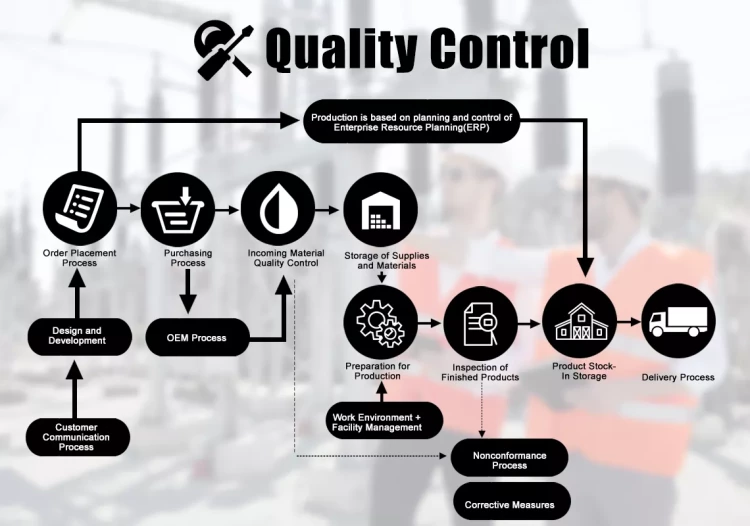
Warnings
Operator safety is the top important issue! Please operate the equipment with cautions. Working with inflammable& explosive or toxic gases is very dangerous, operators must take all necessary precautions before starting the equipment. Working with positive pressure inside the reactors or chambers is dangerous, operator must fellow the safety procedures strictly. Extra caution must also be taken when operating with air-reactive materials, especially under vacuum. A leak can draw air into the apparatus and cause a violent reaction to occur.
Designed for You
KinTek provide deep custom made service and equipment to worldwide customers, our specialized teamwork and rich experienced engineers are capable to undertake the custom tailoring hardware and software equipment requirements, and help our customer to build up the exclusive and personalized equipment and solution!
Would you please drop your ideas to us, our engineers are ready for you now!
FAQ
What Is Laboratory Vacuum Pump?
What Is A Freeze Dryer And How Does It Work?
What Is The Purpose Of Vacuum Pump In Laboratory?
What Are The Main Applications Of Freeze Dryers?
What Is The Use Of Pump In Laboratory?
What Are The Different Freeze Drying Methods Available?
What Is Used In A Laboratory To Form And Contain A Vacuum?
What Are The Key Advantages Of Freeze Drying Compared To Other Drying Methods?
How Does A Laboratory Vacuum Pump Work?
What Factors Should I Consider When Choosing A Freeze Dryer?
What Types Of Freeze Dryers Are Available For Laboratory Use?
Why Is Freeze Drying Preferred For Pharmaceutical Applications?
4.8
out of
5
This vacuum pump is a game-changer! Say goodbye to water waste and contamination with this eco-friendly alternative.
4.9
out of
5
Efficient and reliable, this vacuum pump has been a great addition to our lab. Highly recommend!
4.7
out of
5
The technological advancements in this vacuum pump make it a must-have for any modern laboratory. Bravo!
4.6
out of
5
Compact and powerful, this vacuum pump fits seamlessly into our lab space and delivers impressive performance.
4.8
out of
5
The ease of maintenance and durability of this vacuum pump make it a worthwhile investment for any lab.
4.9
out of
5
The vacuum pump's intuitive design and user-friendly interface make it a breeze to operate. Highly satisfied!
4.7
out of
5
The quick delivery and exceptional customer service made the purchase of this vacuum pump an absolute pleasure.
4.6
out of
5
The vacuum pump's exceptional value for money makes it an unbeatable choice for cost-conscious labs.
4.8
out of
5
The vacuum pump's robust construction and attention to detail make it a durable workhorse in our laboratory.
REQUEST A QUOTE
Our professional team will reply to you within one business day. Please feel free to contact us!
Related Products
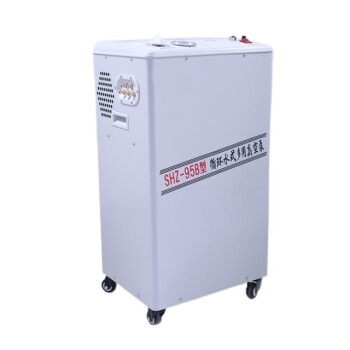
Laboratory Vertical Water Circulating Vacuum Pump for Lab Use
Looking for a reliable water circulating vacuum pump for your lab or small-scale industry? Check out our Vertical Water Circulating Vacuum Pump with five taps and a larger air sucking amount, perfect for evaporation, distillation, and more.

Laboratory Rotary Vane Vacuum Pump for Lab Use
Experience high vacuum pumping speed and stability with our UL-certified Rotary Vane Vacuum Pump. Two-shift gas ballast valve and dual oil protection. Easy maintenance and repair.

Electric Heated Hydraulic Vacuum Heat Press for Lab
The Electric Vacuum Heat Press is a specialized heat press equipment that operates in a vacuum environment, utilizing advanced infrared heating and precise temperature control for high quality, rugged and reliable performance.

Laboratory Sterilizer Lab Autoclave Pulse Vacuum Lifting Sterilizer
The pulse vacuum lifting sterilizer is a state-of-the-art equipment for efficient and precise sterilization. It uses pulsating vacuum technology, customizable cycles, and a user-friendly design for easy operation and safety.

Laboratory Sterilizer Lab Autoclave Pulsating Vacuum Desktop Steam Sterilizer
The pulsating vacuum desktop steam sterilizer is a compact and reliable device used for rapid sterilization of medical, pharmaceutical, and research items.

High Pressure Laboratory Vacuum Tube Furnace Quartz Tubular Furnace
KT-PTF High Pressure Tube Furnace: Compact split tube furnace with strong positive pressure resistance. Working temp up to 1100°C and pressure up to 15Mpa. Also works under controller atmosphere or high vacuum.

Efficient split chamber CVD furnace with vacuum station for intuitive sample checking and quick cooling. Up to 1200℃ max temperature with accurate MFC mass flowmeter control.

Get versatile lab performance with KinTek KCBH 30L Heating Chilling Circulator. With max. heating temp of 200℃ and max. chilling temp of -80℃, it's perfect for industrial needs.

Get all-in-one heating, chilling, and circulating capabilities with our KinTek KCBH 80L Heating Chilling Circulator. High efficiency, reliable performance for labs and industrial applications.

Laboratory Vacuum Tilt Rotary Tube Furnace Rotating Tube Furnace
Discover the versatility of Laboratory Rotary Furnace: Ideal for calcination, drying, sintering, and high-temperature reactions. Adjustable rotating and tilting functions for optimal heating. Suitable for vacuum and controlled atmosphere environments. Learn more now!

1700℃ Controlled Atmosphere Furnace Nitrogen Inert Atmosphere Furnace
KT-17A Controlled atmosphere furnace: 1700℃ heating, vacuum sealing technology, PID temperature control, and versatile TFT smart touch screen controller for laboratory and industrial use.

CF KF Flange Vacuum Electrode Feedthrough Lead Sealing Assembly for Vacuum Systems
Discover high-vacuum CF/KF flange electrode feedthroughs, ideal for vacuum systems. Superior sealing, excellent conductivity, and customizable options.
Related Articles

Water Circulating Vacuum Pumps: A Practical Guide for Laboratory Applications
Discover the benefits of water circulating vacuum pumps for labs: chemical safety, low maintenance, and explosion-proof operation. Ideal for sensitive applications.

How to Choose Laboratory Vacuum Pumps for Maximum Efficiency and Cost Savings
Learn how to choose the right lab vacuum pump for efficiency & cost savings. Compare oil-sealed vs. oil-free pumps & future-proof your investment.

How to Choose and Optimize Water Circulating Vacuum Pumps for Your Lab
Learn how to choose and optimize water circulating vacuum pumps for lab applications, balancing efficiency and reliability.

Choosing the Right Rotary Vacuum Evaporator for Your Lab
Rotary vacuum evaporators are essential tools for any laboratory that needs to concentrate or isolate solutions. These devices work by heating a sample under vacuum to increase its surface area and effectively remove solvent.

Discover The Benefits of Using A Rotary Evaporator
Rotary evaporators are essential laboratory equipment used in the process of separating solvents from samples. These devices work by evaporating the solvent from the sample under a reduced pressure and controlled temperature.

Step-by-Step Guide to Operating a Short Path Distillation Apparatus
Operating of Short Path Distillation and Precautions

Exploring the Science Behind Rotary Evaporators: How They Work and Their Applications
Rotary evaporators, also known as rotovaps or rotating evaporators, are commonly used in labs to remove solvents from samples or to create concentrated solutions. These devices work by rotating a flask or sample container at a high speed while simultaneously heating and evaporating the solvent.

A Step-by-Step Guide to Using a Rotary Vacuum Evaporator for Solvent Removal
A rotary vacuum evaporator is a laboratory instrument used for solvent removal, concentration, and purification. It is composed of a vacuum pump, a heating bath, a rotating flask, and a condenser.

The Importance of Water Distillation in the Laboratory: Ensuring Purity and Quality for Accurate Results
Water distillation is an important process in the laboratory, as it ensures the purity and quality of the water being used in experiments and testing procedures.

From Chemistry to Cooking The Versatility of Rotary Vacuum Evaporator
A rotary vacuum evaporator is a laboratory equipment that uses a rotating flask to remove solvents from a sample. It works by creating a vacuum in the system, which lowers the boiling point of the solvent and allows it to evaporate at lower temperatures.

Advantages of Laboratory Circulating Water Vacuum Pumps
Explores the benefits of using laboratory circulating water vacuum pumps over traditional methods.

Why Tap Water Chilling Is Not Enough for Your Rotavap
Proper chilling is crucial for many laboratory applications, including rotavap. Without proper cooling, the solvent vapor produced during the rotavap process may condense in the wrong place and affect the quality of the final product.